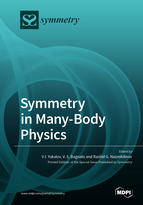Symmetry in Many-Body Physics
A special issue of Symmetry (ISSN 2073-8994). This special issue belongs to the section "Physics".
Deadline for manuscript submissions: closed (31 August 2022) | Viewed by 27674
Special Issue Editors
Interests: statistical physics; phase transitions; coherent phenomena; nonlinear processes; complex systems; mathematical methods
Special Issues, Collections and Topics in MDPI journals
Interests: Bose-Einstein condensation; trapped atoms; turbulence
Special Issues, Collections and Topics in MDPI journals
Interests: transport in nanostructures; graphene; random matrix approach; nuclear structure
Special Issues, Collections and Topics in MDPI journals
Special Issue Information
Dear colleagues,
The harmony of nature is expressed through the implementation of symmetry providing optimal structures for complex systems from snowflakes to graphene lattices. Sometimes nature breaks symmetry, as it happens in a sugar molecule, in the case of the predominance of people with heart on the left side, or in various phase transitions. Symmetry plays a crucial role in many-body physics. For instance, chiral symmetry is important in unusual properties of graphene and in the theory of strong interactions. Symmetry breaking and restoration constantly happens in the world around us.
Usually, finding exact solutions to the problem of interacting particles presents a fundamental challenge. Therefore, we have to restrict ourselves to approximate solutions that reflect the essential features of the entire problem as a whole and contain an indication of the range of applicability of these solutions. An important role in finding approximate solutions is played by the knowledge of basic symmetries that determine the accuracy of the used approximations.
The purpose of this issue is to demonstrate the principal role of exact and approximate symmetries in solving various problems of many-particle physics, as well as in finding approximate solutions for the systems typical of condensed matter, trapped Fermi and Bose gases, nuclear matter, and field theory.
Prof. V.I. YukalovProf. V. S. Bagnato
Dr. R.G. Nazmitdinov
Guest Editors
Manuscript Submission Information
Manuscripts should be submitted online at www.mdpi.com by registering and logging in to this website. Once you are registered, click here to go to the submission form. Manuscripts can be submitted until the deadline. All submissions that pass pre-check are peer-reviewed. Accepted papers will be published continuously in the journal (as soon as accepted) and will be listed together on the special issue website. Research articles, review articles as well as short communications are invited. For planned papers, a title and short abstract (about 100 words) can be sent to the Editorial Office for announcement on this website.
Submitted manuscripts should not have been published previously, nor be under consideration for publication elsewhere (except conference proceedings papers). All manuscripts are thoroughly refereed through a single-blind peer-review process. A guide for authors and other relevant information for submission of manuscripts is available on the Instructions for Authors page. Symmetry is an international peer-reviewed open access monthly journal published by MDPI.
Please visit the Instructions for Authors page before submitting a manuscript. The Article Processing Charge (APC) for publication in this open access journal is 2400 CHF (Swiss Francs). Submitted papers should be well formatted and use good English. Authors may use MDPI's English editing service prior to publication or during author revisions.
Keywords
- graphene
- nonlinear transport
- symmetry in nuclei
- chiral symmetry
- gauge symmetry
- scaling symmetry
- fractals
- symmetry breaking and restoration
- local symmetry
- coexistence of different symmetries
- mesoscopic symmetry fluctuations








